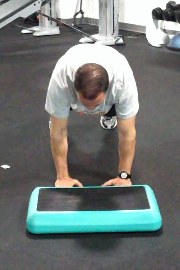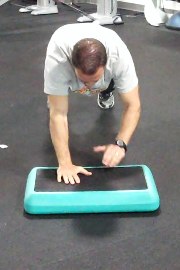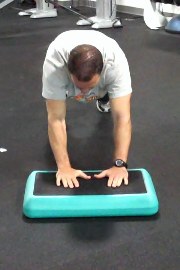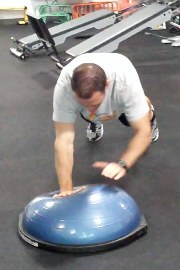Functionally Fit continues with part two of its shoulder miniseries. In this installment, Brian details a three-step routine, upper-body step-ups, along with a bonus BOSU version!
See 'Related Resources' below for past Functionally Fits (including the shoulder series) and other exercises and training tips.
Execution
 |  |  |
START | LIFT | FINISH |
Begin in the traditional push-up finish position, keeping the hands and feet shoulder-width apart. Lift and place the right hand on the box, followed by the left hand. Repeat the sequence as you lower each arm back to the floor. That is one repetition.
Perform 10-15 repetitions or for a specified amount of time. Repeat one to three sets as desired.
Application
This exercise is an excellent shoulder stability training tool that I implement as part of pre-hab, rehab or a shoulder warmup series. It should be included for clients suffering from instability or in need of scapular stabilization training and upper-body strengthening/proprioceptive training.
Additional Notes
This exercise can be modified by having the client begin in kneeling and learning to master the form. As they progress, you may opt to increase the box height, move to the toes, add a weight vest or even introduce an unstable surface, such as a BOSU (see below for the "lift" step on the Balance Trainer).
 |
BOSU LIFT |
I prefer a slower pace to ensure more time under tension during single-arm support and to create maximal co-contraction and stabilization at the shoulder joint. If you train gymnasts, swimmers or overhead athletes who require more ballistic training, then my recommendation is to clearly distinguish between warmup/stability training versus teaching this exercise for speed/power development. The client must have sound stability prior to working on advanced power progressions.
Since the shoulder joint is inherently unstable, never compromise form for higher loads and excess volume. Additionally, keep a watchful eye out for compensations you may see, such as turning the hands excessively in and out, rotating the trunk, pelvic drop or faulty spinal alignment as these signs may indicate kinetic chain weakness, shoulder pain or improper muscle recruitment.
Brian Schiff, PT, CSCS (www.brianschiff.com) is a licensed physical therapist, respected author and fitness professional. He became a Certified Strength and Conditioning Specialist (CSCS) in 1998. In 2000, he opened his own personal training and sport-specific conditioning facility, Fitness Edge, in Dublin, Ohio. Brian has presented at several professional conferences and seminars on injury prevention and sport-specific training.















